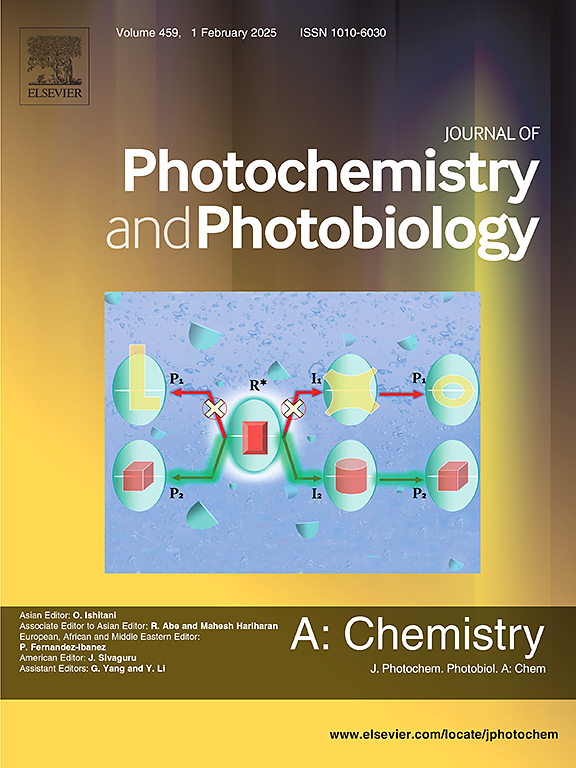Highly sensitive red-emitting carbon dot-based fluorescence sensor for simultaneous detection of copper ions and L-histidine in environmental and biomedical samples
IF 4.1
3区 化学
Q2 CHEMISTRY, PHYSICAL
Journal of Photochemistry and Photobiology A-chemistry
Pub Date : 2025-06-23
DOI:10.1016/j.jphotochem.2025.116588
引用次数: 0
Abstract
The detection of Cu2+ ions and L-histidine (L-His), which are crucial trace elements and amino acids in biological systems, is of paramount importance for environmental health, food safety, and clinical diagnosis. However, conventional detection methods often suffer from drawbacks such as complexity, time-consuming procedures, and high costs. To address these challenges, we have developed an efficient, sensitive, and straightforward detection techniques. In this study, we successfully synthesized red-emitting carbon dots (R-CDs) with a remarkable quantum yield of 26.6 % and devised an R-CDs-based fluorescence sensor that operates via an “on-off-on” mode for the simultaneous detection of Cu2+ ions and L-His. The sensor's working principle involves the static quenching of R-CDs fluorescence upon the addition of Cu2+ ions, followed by the restoration of fluorescence through the competitive binding of L-His to Cu2+ ions. This approach enables the ultrasensitive detection of Cu2+ ions and L-His, with detection limits as low as 0.58 μM and 0.45 μM, respectively. The sensor has been effectively applied to detect Cu2+ ions in environmental water samples and L-His in human blood, food additives, and health-care products. It demonstrates excellent selectivity, strong anti-interference ability, and high accuracy, with recovery rates ranging from 95.0 % to 105.0 %. Owing to its simplicity, rapidity, cost-effectiveness, and high sensitivity, the proposed R-CDs-based fluorescence sensor holds great promise as a valuable tool for environmental monitoring, food safety assessment, and clinical diagnosis. Future efforts will focus on further optimizing the sensor's performance and exploring its applications in a broader range of real-world samples, thereby providing substantial support for scientific research and technological advancements in related fields.

高灵敏度的红色碳点荧光传感器,用于同时检测环境和生物医学样品中的铜离子和l -组氨酸
Cu2+离子和l -组氨酸(L-His)是生物系统中重要的微量元素和氨基酸,其检测对环境卫生、食品安全和临床诊断具有重要意义。然而,传统的检测方法往往存在复杂、耗时和高成本等缺点。为了应对这些挑战,我们开发了一种高效、灵敏、直接的检测技术。在这项研究中,我们成功地合成了红发碳点(R-CDs),其量子产率达到了26.6%,并设计了一种基于R-CDs的荧光传感器,该传感器通过“开-关-开”模式同时检测Cu2+离子和L-His。该传感器的工作原理是在加入Cu2+离子后,R-CDs荧光静态猝灭,然后通过L-His与Cu2+离子的竞争结合恢复荧光。该方法可实现Cu2+离子和L-His的超灵敏检测,检测限分别低至0.58 μM和0.45 μM。该传感器已有效应用于环境水样中的Cu2+离子和人体血液、食品添加剂、保健品中的L-His的检测。该方法选择性好,抗干扰能力强,准确度高,回收率为95.0% ~ 105.0%。由于其简单,快速,成本效益和高灵敏度,所提出的基于r - cds的荧光传感器在环境监测,食品安全评估和临床诊断方面具有很大的前景。未来的工作将集中在进一步优化传感器的性能,并探索其在更广泛的现实世界样本中的应用,从而为相关领域的科学研究和技术进步提供实质性的支持。
本文章由计算机程序翻译,如有差异,请以英文原文为准。
求助全文
约1分钟内获得全文
求助全文
来源期刊
CiteScore
7.90
自引率
7.00%
发文量
580
审稿时长
48 days
期刊介绍:
JPPA publishes the results of fundamental studies on all aspects of chemical phenomena induced by interactions between light and molecules/matter of all kinds.
All systems capable of being described at the molecular or integrated multimolecular level are appropriate for the journal. This includes all molecular chemical species as well as biomolecular, supramolecular, polymer and other macromolecular systems, as well as solid state photochemistry. In addition, the journal publishes studies of semiconductor and other photoactive organic and inorganic materials, photocatalysis (organic, inorganic, supramolecular and superconductor).
The scope includes condensed and gas phase photochemistry, as well as synchrotron radiation chemistry. A broad range of processes and techniques in photochemistry are covered such as light induced energy, electron and proton transfer; nonlinear photochemical behavior; mechanistic investigation of photochemical reactions and identification of the products of photochemical reactions; quantum yield determinations and measurements of rate constants for primary and secondary photochemical processes; steady-state and time-resolved emission, ultrafast spectroscopic methods, single molecule spectroscopy, time resolved X-ray diffraction, luminescence microscopy, and scattering spectroscopy applied to photochemistry. Papers in emerging and applied areas such as luminescent sensors, electroluminescence, solar energy conversion, atmospheric photochemistry, environmental remediation, and related photocatalytic chemistry are also welcome.

 求助内容:
求助内容: 应助结果提醒方式:
应助结果提醒方式:


